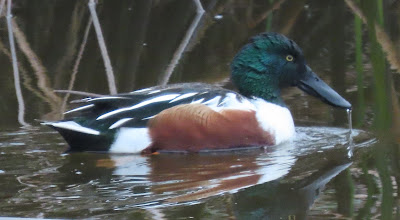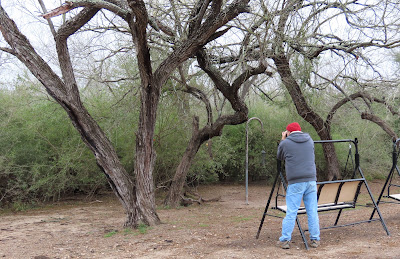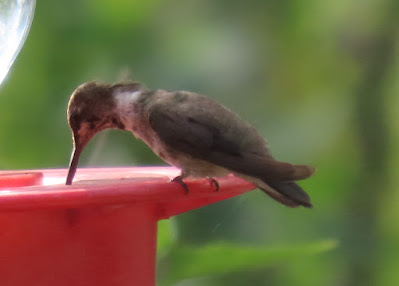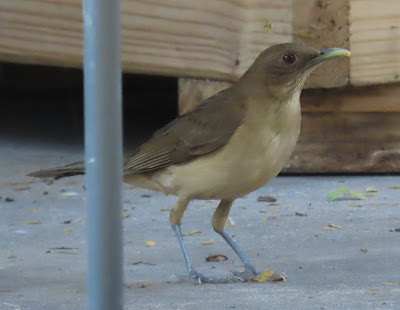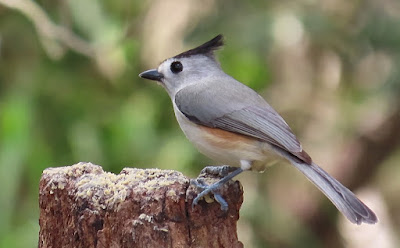2/25/22
Mary from Houston had won a silent auction bid at their local Audubon fundraiser for a three-night stay at the Inn (with a half day of guiding), so she and her other half Tom were finally able to get away and use it! Problem was, a cold front arrived the night before our outing, so it never got above 43 all day and was misty to boot! L (Thankfully it was for only a half day…) We were playing the itinerary by ear (because sometimes down here they predict rain but it never happens) and I gave them several options, but the possibility of the continuing Bat Falcon was too tempting to pass up, so I met them at the Inn at 6:30 and we headed down to Santa Ana in the mist!
The bird wasn’t on “his” post when we arrived, so as we pondered how to wait for him while still staying dry, we noticed a guy pulled over on the west-bound shoulder, so we swung around and pulled up behind him with a ring-side view of the “stage”! (Some other folks were parked along the entrance road, but it didn’t look like anyone was enforcing the “no parking” rule in that weather…) We gave it until 7:30 with no falcon L, but we did log the day’s only White-tailed Kite pumping by!
Since the mist seemed pretty light by that point,
we went ahead and parked in the lot to hike the Chachalaca Trail. Three Kiskadees showed off right away, but a
titmouse in the parking lot was less cooperative. We poked along the road and
over on the levee to the trail, all bundled like Eskimos; naturally it was
pretty quiet, but a troupe of Green Jays happened by, giving everyone great
looks! An Olive Sparrow lisped unseen,
but no other songbirds showed themselves for the first part of the trail. We did hear a distant Carolina Wren, which
prompted a story from Mary about how they would nest in an empty pack in their
golf cart if they didn’t use it very often!
All the action was at Willow Lakes: we had a good assortment of water birds including both grebes, Shovelers, Blue- and Green-winged Teal, Coots, Common Gallinules, and a hiding Sora whining. A Ringed Kingfisher machine-gunned and then shot by too fast to get a good look at, and later a Belted Kingfisher did the same. Over at the blind were both flavors of egrets along with a couple of immature spoonbills, plus a female Yellowthroat that deigned to let us see her! At the far deck were more birds than I’d seen there in a long time: a big flock of Long-billed Dowitchers and Least Sandpipers fed on the “sand bars”, while a large group of White Ibis huddled together along with more Snowy Egrets. White Pelicans sailed overhead, and Mary and Tom were surprised to find out that the Whites are actually quite a bit bigger than the Browns they have in Houston (and here, of course)!
On the way back I was surprised at a cooperative pair of Verdins who came in close to investigate (but frustrated Tom to no end in his photographic endeavors as the silly bird was in constant motion J). A Golden-fronted Woodpecker was more cooperative, however!
They wanted to see the Rio Grande, so that was a
good excuse to go to Anzalduas Park and road-bird a little! On the way in we logged a Loggerhead Shrike
that liked the chain-link fence up on the levee, and as always enjoyed pointing
out that one is looking north into Mexico at that point! We
forewent the Pipit Poke seeing as it was still misty and the field was probably
wet (to say nothing of the fact that the last couple of times I looked for them
I came up empty L), but we did pull over and scan the river from the car, adding the scaup and coot
flock, plus a Ring-billed Gull, Double-crested Cormorant, and a couple of
Caspian Terns! The big mass of vultures
I had seen sitting on the grass the last two times apparently had left for
drier parts…
As we made the right and rolled by closer to the river (where a lone Lesser Scaup was closer among the Coots), suddenly another Ringed Kingfisher let loose, and this time we spotted him as he made several circles and landed on the island where we all got great looks at his chestnut breast! (Took a little while to point him out as it was hard to find a clear window through the brush…) The Osprey that had been whistling suddenly materialized on a dead snag, and we were able to get a tiny bit closer to the Caspian Terns so that their red bills were visible (if you had 10x bins J)! Four Killdeer lined the little ridge, so that was fun to see.
The back side of the park was still closed due to immigrant COVID testing, so we crawled along the rest of the open park, but things were just simply dead. We still had a little time yet with no other road-birding options, so we decided to try Bentsen for some feeder birds, and that turned out to be a great decision as the “wet” totally went away when we got there! On the way in a Long-billed Thrasher serenaded us and provided great photo and video ops, and the new PB feeder outside the Visitor Center window (as well as the platform feeder) was being attacked by Cardinals and Green Jays, along with Inca Doves on the ground picking up the leftovers! After checking in we headed straight to La Familia Nature Center and the feeders there, adding a Great Blue Heron and Great Egret along the canal (we lost Tom briefly as he was taking pictures of the Border Wall…J)!
That place
was hopping! Chachalacas were all over
the floor, and a pair of Altamira Orioles were fighting with the blackbirds
over the sunflower seed feeder! The
requisite Green Jays and Cardinals were going back and forth, and on the other
side we picked up the White-tipped Dove.
All too soon it was time to head back, so after getting “we were there”
pictures of Mary and Tom with the Border Wall in the background J, we stopped in the VC for
a snack before heading home (and Mary braved the freeway construction famously
– all she had to say to calm my fears was, “I drive in Houston!” J)!
Mary shooting the Chachalaca mob (below)
Tom shooting the Altamira Oriole (below)
The morning’s list was pretty dismal with only 44 species, but
considering the weather we had to deal with, that wasn’t bad! Bird list:
Blue-winged Teal
Northern Shoveler
Mottled Duck
Green-winged Teal
Lesser Scaup
Plain Chachalaca
Least Grebe
Pied-billed Grebe
White-tipped Dove
Sora
Common Gallinule
American Coot
Killdeer
Least Sandpiper
Long-billed Dowitcher
Ring-billed Gull
Caspian Tern
Double-crested Cormorant
Great Blue Heron
Great Egret
Snowy Egret
White Ibis
Roseate Spoonbill
Turkey Vulture
Osprey
White-tailed Kite
Ringed Kingfisher
Belted Kingfisher
Golden-fronted Woodpecker
Ladder-backed Woodpecker
Great Kiskadee
Loggerhead Shrike
Green Jay
Black-crested Titmouse
Verdin
Carolina Wren
Long-billed Thrasher
Olive Sparrow
Altamira Oriole
Red-winged Blackbird
Great-tailed Grackle
Orange-crowned Warbler
Common Yellowthroat
Northern Cardinal









